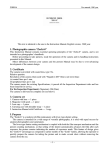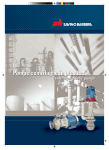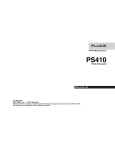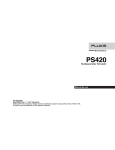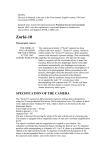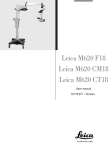Download Zorki 6 Operating Instructions
Transcript
NOTE:
This text is identical to the one in the Instruction Manual,
English version, 1960 year, and converted to HTML in
2001. In the existing original (pre-press?) there are no
pictures... (we took them from the Russian version)
ПРИМЕЧАНИЕ:
Данный текст идентичен оригинальному
Руководству английской версии 1960 года, и
специально подготовлен для формата HTML в 2001
году. В имеющемся оригинале рисунки
отсутствуют... (взяты из русской версии)
PHOTOGRAPHIC CAMERA
"ZORKI-6"
This Instruction Manual contains essential operating principles of the "Zorki-6"
camera, and is not intended as a photographer's handbook.
Before proceeding to take pictures, study the operation of the camera and its handling
instructions presented in this Manual.
Minor differences between your camera and the present Manual may be due to everadvancing development of the camera design.
CERTIFICATE
The camera is provided with coated lens,
type: No.
Relative aperture
Resolution of the camera when used with "Negaitive-M3" film is not lower than:
(a) central
lines per 1 mm,
(b) peripheral
lines per 1 mm
The camera meets the existing Specifications; it passed all the Inspection Department
trials and has been found fit for service.
For the Inspection Department: (Signature)
196
(Date)
The camera is delivered in complete set (see below).
CAMERA SET
1. Camera with lens -- 1 piece
2. Magazine with spool -- 1 piece
3. Lens cap -- 1 piece
4. Carrying case with shoulder strap -- 1 piece
5. Instruction Manual with Certificate -- 1 copy
I. PURPOSE
The "Zorki-6" is a modern roll-film minicamera with lever-type shutter setting.
The camera is intended for a wide range of versatile photography; it is used with
equal success by amateur photographers and cameramen.
The lever-type shutter setting mechanism is coupled with both the film transport
mechanism and the picture counting mechanism, so that setting of the shutter
automatically advances the film after each exposure, the picture counter indicating the
number of exposures made. This feature of design gives the "Zorki-6" advantages as
compared to earlier models of the "Zorki" family, allowing the operator to quickly
prepare the camera for taking the picture and to make several shots without removing
the camera from the eye.
II. DESCRIPTION
The camera is fitted with either of the three lenses listed below:
(a) lens "Industar-26M";
(b) lens "Jupiter-8";
(c) lens "Industar-50" (Fig. 1), in sliding and fixed mounts.
All these lenses have their advantageous features: the two first lenses possess high
(maximum) rapidity, while the third lens has a somewhat increased resolution all over
the picture area.
The lenses are anastigmatic, with coated optical surfaces and inner iris diaphragms.
Focal length -- 5 cm.
Angular field of view -- 45°
Relative aperture range:
"Industar-50" lens -- 1:3.5; 1:4; 1:5.6; 1:8; 1:11; 1:16;
"Industar-26M" lens -- 1:2.8; 1:4; 1:5.6; 1:8; 1:11; 1:16; 1:22;
"Jupiter-8" lens -- 1:2; 1:2.8; 1:4; 1:5.6; 1:8; 1:11; 1:16; 1:22.
Minimum focussing range -- 1 m.
Working distance of the camera, i.e. distance between the lens end plane and the
image plane of infinitely removed objects, amounts to 28.8 mm.
Mounting diameters for attachments (sun shades, light filters, extension lenses, etc.)
are:
for the "Industar-50" lens -- 36 mm;
for the "Industar-26M"
and "Jupiter-8" lenses -- 42 mm.
Fig. 1
Threads for screwed-in attachments (light filters and extension lenses):
in the sliding-mount "Industar-50" lens -- 23x0.5 mm; in the "Industar-26M" and
"Jupiter-8" lenses -- 40.5x0.5 mm; in the fixed-mount "Industar-50" lens -- 33x0.5
mm.
Picture sizes 24 by 36 mm, the camera using 35-mm perforated film.
The camera magazine accommodates 1.65-m length of motion picture film, sufficient
for making 36 exposures.
The camera is equipped with a curtain shutter providing for momentary speeds of
1/30; 1/60; 1/125; 1/250 and 1/500th of a second.
Besides, hand-controlled time exposures (with the shutter set opposite letter "B") and
duration exposures are obtainable.
Exposure speeds may be set with the shutter either set up or released. It should be
borne in mind that the shutter speed dial must be turned over the scale only from letter
"П" toward figures 30, 60, 125, 250 and 500, and then back again.
Never rotate the dial with:n the interval between "B" and "500", as in this
instance the mechanism is likely to be damaged.
The camera shutter is set up by means of a shutter-setting lever linked with the film
transport mechanism and the picture counting mechanism. Shutter is being re-set as
the film is advanced for the next exposure and the picture counting dial travels
through one division.
The optical range-finder (base 67 mm) is linked with the focussing system. The
optical view-finder and the range-finder are combined in the same field of view, and
have a common eyepiece.
The magazine used with the camera is a split metal piece made absolutely light-proof.
The mounting thread of the camera lens seat is standard for different camera makes
and suits all main and interchangeable lenses used with photographic cameras of the
"Zorki" family.
Overall Dimensions of Camera
Width, mm -- 135
Height, mm -- 80
Length in operating position, mm -- 70
The camera can be operated without removing it from the carrying case. The camera
(in the case) can be screwed to a tripod.
The flexible releaser is screwed into the thread provided in the shutter release button.
When used, the flexible releaser reduces the probability of camera shifting caused by
the shutter release.
Fig. 2
III. OPERATION
1. Removing, Replacing, Opening and Closing the Camera (Fig. 6)
Rotate the camera stand nut counterclockwise to unscrew it from the camera base
plate, and take the camera from the carrying case.
Pull lock 27 all the way up, and then open back cover 25. Take-up spool 23 will not
be removed from the camera. Magazine 22 yields only after film reverse take-up knob
7 has been brought up. The camera is closed and replaced in the reverse order. It
should be remembered that the camera is provided with a magazine which is
automatically opened inside the camera under the pressure of a pin fitted in the lower
part of the back cover. Therefore, easy locking of the back cover requires that the
botton edge of the camera should be pressed tight against the camera body. Prior to
closing the cover of the carrying case, see that the lens is set at infinity ("∞"), or
sunk inside the camera if its mount is sliding.
2. Magazine Loading (Fig. 3)
The magazine 22 of the "Zorki-6" camera consists of outer casing, inner casing and
central spool.
To open and strip the magazine, press off the lock spring until it has cleared its seat
and withdraw the inner casing with spool from the outer casing.
Load and unload magazine by red light or in full darkness, depending on the film sort.
Fig. 3
Cut the film end as shown in Fig. 4, and insert it into one of the spool slits, from the
wider side. As the spool is held with its head facing inside, the emulsion side of the
film faces downward.
Fig. 4
The film end showing on the other side of the slit should be bent and passed into the
second slit, from its narrower side. Then the remaining length of the film end should
be bent threefold, and the film tightened so that the bent end is wedged in the slit.
Holding the spool so as to face its head, roll the film on to it with the emulsion side
inward (toward the spool stem), rotating the spool counterclockwise. Do not attempt
to pull the film already rolled on the spool with a view to tightening it as the action
causes scratches on the emulsion face of the film. The film should be held carefully
by its sides so that no finger-prints are left on its emulsion side.
Fig. 5
Insert the film-loaded spool in the inner casing so that the spool head fits into the
opening in the casing bottom. A 8 to 10-cm length of film end should be left free.
Insert the inner casing with the film spool into the outer casing. The inner casing
should be latched inside the outer casing with the locking spring which enters the
recess on the magazine outer casing edge.
After that, the magazine can be handled by daylight.
Note. The "Zorki-6" camera can be used with other types of film magazines, too,
provided their sizes meet the Specifications for the standard magazine delivered with
the "Zorki-6" camera set.
3. Camera Loading (Figs. 1, 2, 4)
Prior to loading the camera, make sure that the shutter mechanism is engaged and
operative.
See that buttons 2 and 4 are brought to their upward positions. Set the camera shutter
by turning lever 21 as far as it will go. Pull shutter speed dial 5 up and set it at the
selected division opposite the index made on the dial axle. When released, the shutter
speed dial should go down to assume position in which the dial upper surface stands
almost level with the index plane.
If the shutter mechanism operates upon pressing shutter release button 2, the camera
mechanism is sound and the camera may be loaded. Pull a 10-cm length of film out of
the magazine (Fig. 4), and, if necessary, cut it accurately by about half the film width.
When cutting, see that the cut does not run through perforation holes. The film end
should be cut carefully, without burrs and ruptures involved to obviate the film
stickings in the film guides, or its breaking, which brings about fouling or even failure
of the camera.
Open the camera back cover, secure the film end under the take-up spool spring, and
make sure that the uncut film edge closely fits the spool flange. When the magazine
is being inserted in the camera or removed from it, the film reverse take-up knob
should be in its upward position.
Loading or unloading over, lower the reverse take-up knob as far as it will go.
Fig. 6
Close the camera back cover and press the lock downward.
To advance the first unexposed film frame to the frame window, set and release the
shutter three times.
When the shutter is being set, film reverse take-up knob 7 should spin. If the knob
fails to revolve, check the camera for correct loading with film. However, it should be
remembered that this is also likely to take place during the first few film transport
cycles if the magazine is loaded with a film which is much shorter than the normal
length. In this case, the reverse take-up knob will begin rotating only when the film
tension on the magazine spool is sufficient.
Rotate picture counting dial 1 (holding it by the knurled surface), to set its zero mark
against the index dot on the camera top surface.
This done, the camera is considered loaded.
Reverse take-up knob 7 mounts film sort dial 8. Holding the film sort dial by its
knurled surface and retaining the reverse take-up knob with the other hand, rotate the
film sort dial until the film sort index stands opposite the dial mark corresponding to
the sensitivity of the film used.
The silhouette of a lamp and the sun with rays marked next to the inscription
COLOUR (ЦВЕТНАЯ) identify colour film for artificial and day-light photography.
Figures 11, 22, 45, 90 and 180 denote film sensitivities according to the existing
system of film sensitivity standards. If, for instance, the camera is loaded with a
black-and-white film of a 65-unit sensitivity, the index should be set at the
corresponding graduation between Figures 45 and 90.
4. Camera Optical System: Lens, Range-Finder, View-Finder (Figs. 1
and 2)
Before taking pictures, study the construction of the camera lens.
The "Industar-50" is of a sliding version; when the camera is not expected to be used,
the lens is drawn into the camera. When slide in, the lens projects from the camera but
slightly. To place this lens in the operating position, pull the lens out holding it by
ring 12, and, having fitted the cams in their recesses, turn the lens clockwise, seeing
that it is fixed tight in position, without slightest play involved.
The "Industar-26M", "Jupiter-8" and the fixed version of the "Industar-50" do not
require the above mentioned operations, as their mounts are permanently fixed in the
camera bodies.
The lens is irised by rotating diaphragm setting ring 13. The desired lens opening
figure is set on the scale provided on ring 12. The lens should be irised before
focussing.
For focussing, the lens is rotated in its thread by operating lens focussing lever 14 of
the sliding "Industar-50" lens or the focussing ring of the fixed "Industar-50" lens. In
the initial ("∞") positions, the lens mounts are locked by a spring-loaded button
provided on the focussing lever. To release the lever for operation, it is necessary to
press this button.
The lens travel is limited by stops. Distances to the sharp focussing plane are read off
distance scale 10. The distances are indicated by an index with graduations of depthof-field scale 11 spaced symmetrically on either side of the index.
Focussing is done with the aid of the optical range-finder. Observing through rangefinder eyepiece 19, lay the lens to the object to be photographed. In this event, the
central part of the range-finder field-of-view shows a yellowish field against a bluish
background.
Within the borders of this square field, the object observed is seen double-imaged if
the object is not infinitely distant (any distance less than 100 m).
Objects having sharp contours should be selected for focussing. Turn the lens by the
focussing lever (or the focussing ring) to align the two images of the object.
This done, set the lens accurately for the distance to the object to be photographed,
and read this distance off distance scale 10. This focus setting is sure to produce a
sharp picture if the camera is held firm at the picture-taking moment, and the
photographed object is still or moves but not very quickly.
Remember that if the object is located at a distance shorter than 1 m, it is impossible
to superimpose the double images upon each other, and it is vain to use the rangefinder.
Sometimes in the photography practice it is either impossible or inconvenient make
use of the range-finder. In such cases, the lens distance setting can be done directly by
the distance scale graduated in meters. The distance to the object to be photographed
should be known before or measured on the spot.
The view-finder combined with the range-finder in the common field of view
provides for simultaneous framing of the photographed scene. For correct framing,
bring your eye as close to range- and view-finder eyepiece 19 as possible. Apply the
eye strictly to the centre of the eyepiece so that the yellowish-tinted square field is in
the centre of the view- and range-finder field-of-view. Non-observance of this
condition brings about poor picture framing.
The camera view-finder is designed for use with normal lenses of 5-cm focal length.
All the other lenses require view-finders with corresponding picture fields, or a
multifoc view-finder intended for use with five different lenses characterized by
different focal lenghts. Attachement view-finders are inserted in shoe 20 provided on
the camera top surface.
It is advisable to make use of depth-of-field scale 11 when taking pictures, consisting
of paired graduations symmetrically spaced on either side of the index mark and
marked to indicate the lens opening figures. Two distances within which all objects
are produced with sufficient sharpness on the picture are always read against these
graduations on distance scale 10; these two limiting distances are called the close and
far limits of the depth of field.
It may happen that the photographer must be ready to take a picture at any unexpected
moment. In such cases, the lens should be irised close (for example, to relative
aperture of 1:16), and the distance should be set so that the far limit of depth of field
is "∞" (one of the "16" graduations of depth-of-field scale 11 being aligned with mark
"∞" of distance scale 10). In this instance, the other identically-marked graduation of
the depth-of-field scale will show the close depth-of-field limit, i.e. the shortest
distance by which the photographer can approach the object photographed to obtain
sharp picturing of the latter.
5. Flash Synchronizer (Fig. 1)
Flash synchronizer contacts 9 are intended for operating the shutter at the moment of
the flash.
When an electronic (multiple-action) flash is used, the plug of the flash unit
connecting wire should be inserted in the connector socket of the synchronizer contact
marked with a lightning symbol. The flash circuit will be closed the moment the
frame window gets fully opened.
Only shutter speeds of l/30th of a second and slower and hand-controlled long time
exposures may be us!ed when employing flash synchronizer to contacts.
When single-action flash bulbs are used, the flash unit connecting wire should be
plugged in the synchronizer contact marked with a silhouette of an electric bulb. The
flash circuit in this case will be closed with a delay required for the flash bulb to gain
the required luminous power.
6. Automatic Releaser (Self-Timing Device)
"The "Zorki-6" is provided with a self-timing device which is used whenever it is
desired that the picture is taken with a delay and without direct operation of the
photographer. Thus, when the photographer is taking his own picture in a group
portrait, he mounts and lays the camera, cocks up the shutter and sets the self-timing
device; then the photographer actuates the delayed-action mechanism, having enough
time to take his place in the group to be photographed.
Setting the Automatic Releaser for Operation
Set up the shutter and move the delayed-action setting lever all the way
counterclockwise.
Then, press the delayed-action release button at the desired moment for the shutter to
be automatically released with a 9 to 15-second delay. Upon the shutter release action,
the delayed-action setting lever returns to its initial position. The shutter can be set up
both with the set and released self-timing device. However, it is recommended first to
set the shutter and the selected shutter speed, and only then to wind up the self-timing
device.
To avoid undue wear of the self-timing device spring, it is advisable to wind it up
only when required; in all other cases it should be kept released. Should the shutter
speed dial be set opposite letter "B", the exposure speed, with the self-timing device
in operation, will be not faster than one second. As this exposure time varies for
different cameras, it is advisable to check it with the aid of a stopwatch.
The self-timing device of the "Zorki-6" camera can be operated together with a flash
unit.
7. Taking the Picture (Figs. 1 and 2)
When preparing to take a picture:
1. Load the camera. If it was loaded and several exposures have already been taken,
look at the picture counter to see if there is unexposed film left. Make sure the shutter
mechanism is engaged.
2. Remove the cap from the lens. If the camera is fitted with a sliding lens, draw it out
and lock for operation.
3. Set the lens opening as dependent on the desired depth of field. If necessary, fit a
light filter or lens shade on the lens.
4. When taking flash pictures, connect the flash unit to the camera, and check for
reliable plugging.
5. Set the shutter by turning shutter-setting lever 21 as far as it will go.
6. Determine the required exposure and set the exposure speed by pulling shutter
speed dial 5 up and positioning it opposite the desired division. When released, the
dial should sink down and be fixed in the selected position, the dial top surface being
almost level with the index.
The shutter speed may be set either before or after setting the shutter
mechanism. Bear in mind that it is prohibited to rotate shutter speed dial 5 in the
"B" to "500" interval.
7. Observing through view-finder eyepiece 19, lay the camera on the object to be
photographed. Take a position off the object to obtain adequate framing of the
photographed object within the view-finder field.
8. Focus the lens operating the range-finder mechanism.
9. Take the shot by smoothly pressing the shutter release button to prevent jerking of
the camera. This procedure is true for instantaneous exposures, when the camera is
hand-held and no flexible releaser is used.
When taking the picture with the camera in the carrying case, see that the camera case
cover does not get between the object and the lens. This should be remembered
especially when photographing with the camera held vertically.
8. Hand-Controlled and Endurance Exposure Setting
To obtain a hand-controlled shutter speed, letter "B" marked on the shutter speed dial
should be brought against the shutter speed setting index. In this position, the shutter
remains opened as long as shutter release button 2 is held depressed.
The same shutter speed dial setting (at "B") produces considerably delayed
(endurance) exposures. For this purpose, shutter release button 2 should be fixed in
the depressed position by turning the button all the way counterclockwise. In this
position, the shutter remains opened. To release the shutter, turn the button in the
opposite direction and let go of it.
9. Camera Unloading
After making approximately 36 exposures, the shutter-setting lever will resist rotation
and stop the shutter operation. This means that the whole of the film has been exposed
and it is time to re-spool it back to the magazine.
Cover the lens with the cap, and holding button 4 depressed, rotate reverse take-up
knob 7 in the direction of the arrow until the spring of the take-up spool produces the
film (this is indicated by the effort applied for extracting the film from the take-up
spool).
Open the camera back cover having lifted the reverse take-up knob, and remove the
magazine with the exposed film. Keep the magazine closed and intact until the film is
to be developed. Having re-spooled the film, set and release the shutter to check the
work of the mechanism. This done, the camera is again ready for loading.
CAMERA PARTS
(Figs. 1, 2, 3 and 6)
1. Picture counting dial
2. Shutter release button
3. Range-finder object glass, right
4. Shutter mechanism disengaging button
5. Shutter speed dial with index
6. Range-finder object glass, left
7. Film reverse take-up knob
8. Film sort dial
9. Flash synchronizer contacts
10. Lens distance scale
11. Depth-of-field scale
12. Front lens ring with diaphragm scale
13. Diaphragm setting ring
14. Lens focussing lever
15. Delayed-action setting lever
16. Delayed-action release button
17. Eyelet
18. Dioptrical adjustment lever
19. Range- and view-finder eyepiece
20. Attachment shoe
21. Shutter mechanism setting lever
22. Magazine
23. Take-up spool
24. Camera stand nut
25. Back cover
26. Film hold-down plate
27. Lock











